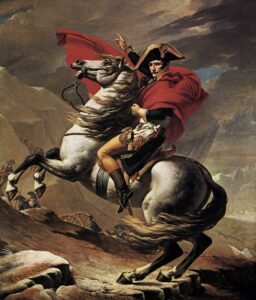The 18th century gave birth to the modern world, but it proved to be a most bellicose and disturbing parent, for this period proved to be the climax of more than a millennium of serfdom, church control and totalitarianism.
In France, the peasants marched on Paris, citizens stormed the Bastille, the army turned against its ruler. In a move that shook all the royal heads of Europe, the people turned their king and queen over to the terrible guillotine and a peoples’ republic was formed which, in its turn, would not be free of bloodshed. From this chaos came the saint of the revolution, Napoleon, who through the worship of the people became a new monarch.
In this time of upheavals emerges one of histories’ greatest painters: Jacques-Louis David. Born to a prosperous family, his spirit was perhaps suited to the age, for he rebelled against his parents expectations: they wished him to be an architect, but he was in love with art. This same fire persuaded his guardians to accept his decision and he ended up attending the Royal Academy where he became adept in both current trend of rococo and the emerging new classicism. After many failed attempts, David won a scholarship to the French Academy in Rome and travelled to Italy. There he saw the ancient artworks of the Romans and the Renaissance wonders of the cities. Classicism became his religion and his god was Raphael.
David joined in the turmoil of the revolution. He befriended Robespierre and put his own signature onto the death warrant of Louis XVI. He painted republican propaganda and was given imperium over the arts of France. When Napoleon became emperor, he commissioned David for numerous pieces. After Napoleon’s fall, David was given amnesty by the renewed Bourbon government, but he chose exile in place of dishonour and moved to Brussels. He died in 1825 shortly after being struck by a carriage after leaving a theatre.
The artwork of David is diverse, and this diversity is due to the varied times through which the artist lived. While in Rome, he produced the masterpiece The Oath of the Horatii, which was to become a chef d’oeuvre of the new movement of Neoclassicism. In it we see the three brothers of the Horatii swearing an oath to fight three brothers from the city of Alba Longa, in order to end hostilities between the former city and Rome. Through excellent use of light and shadow, and the placement of figures on the canvass, all the elements converge to a central point. The painting echoed the sentiments of the time and was an immense achievement for one so young.
Other works painted before the revolution include the Death of Socrates, which one critic described as “in every sense perfect”, as well as The Lictors Bring to Brutus the Bodies of His Sons.
David produced many famous artworks during the revolution, but his creativity was curtailed by the Department of Public Safety which ensured that only Republican propaganda paintings would be produced. He immortalised his place in the revolution when he produced the painting The Death of Marat, which shows the political leader dead in his bath, still clutching the note of suspected seditionists given him by his murderess, Charlotte Corday. The painting idealises the body of the dead leader, bathes him in the golden light of a medieval saint, and in so doing creates a new type of martyr: a man who dies for the good of the Republic.
And in Napoleon Crossing the Alps, one of his finest later works, David paints the emperor mounted on a reared steed, himself displaying a calm and grace which is at juxtaposition with the dark and eerie scene.
You can find quality art on bidorbuy.










